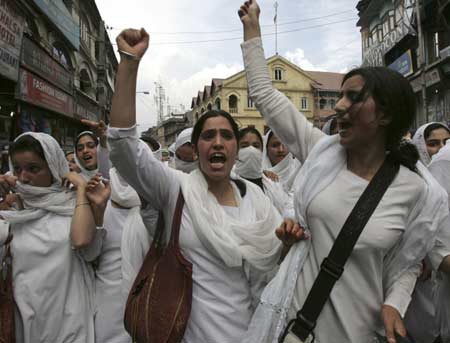By OMAR AKHTAR. http://kashmirreader.com/
Published: Sun, 09 December 2012 10:00 PM
I happen to live in an unfortunate part of the city of Srinagar where electricity fails with immaculate accuracy every few days. While other parts of the city remained well-lit and warm for those days and nights, we had to suffer the after-effects of a combination of ill-luck: non-functioning electric heaters, non-existent kerosene heaters, out-of-work gas heaters, and over-priced firewood which could only warm a room. So our noses are pretty frozen in the mornings, chests congested, and minds foggy from less sleep.
Why? Why? Why?
Maybe the problem is local. Maybe it is not.
I got a part of the answer to that question a few days later, after another night of no power, when I flew to Delhi on a bright, sunny day. I was lucky to get a window seat, so I had the perfect view of the Valley and Doda looking east.
On a sunny day like that, it was not difficult to see another aspect to the problems the state has. I counted three dams on the way south. While one was perhaps bordering on the state, the other two were within the borders. On return, Google Earth helped me locate the two dams in question – Baglihar and Ranjit Sagar Dams.
There are three more we cannot see from the air on the flight to Delhi, that is Uri Dam, Kishenganga Project and Dulhasti, plus two more in the Ladakh and Kargil districts.
To borrow a phrase from the heady 1980’s – It is about the water, stupid!
A permanent, peaceful, political solution to the Jammu and Kashmir issue is being held hostage to the economic needs of India. According to a recent article, the National Hydroelectric Power Corporation Limited (NHPC), generates 5526 MW of power throughout India – of which almost 2000 MW is generated in Jammu and Kashmir alone – and a further 655 MW are under construction, to be commissioned by 2016. According to another article, the potential for power generation in Jammu and Kashmir is over 20,000 MW, which makes it a vastly untapped sector.
Kashmir’s power runs the Metro in Delhi, the Northern Railways’ trains, the large and medium scale industries in Western Uttar Pradesh, Haryana and Punjab, that lights up city centres at night. Still, parts of Jammu and Kashmir reel under darkness. A solution to the conflict is hostage to India’s economic needs
Still, parts of Jammu and Kashmir reel under darkness. The power goes elsewhere.
The NHPC supplies a major part of the Northern Grid, of which a major part comes from power generated in Jammu and Kashmir. But a major part of the power that Jammu and Kashmir generates does not remain in Jammu and Kashmir. Over the last two decades, the exponential growth of industries and real estate in and around Delhi and other major northern Indian cities has been fuelled, in large part, by the availability of power. Power which runs the Metro in Delhi, the Northern Railways’ trains, the large and medium scale industries in Western Uttar Pradesh, Haryana and Punjab, that lights up city centres at night.
Still, parts of Jammu and Kashmir reel under darkness.
In a systematic way, the resources of Jammu and Kashmir, that are renewable, no less, have been siphoned off for use elsewhere, with a whimper of protest from the active civil society which got nothing more than a nod of acknowledgement.
The Jammu and Kashmir Water Resources Act of 2010 allows for the charging of fees from use of water for purposes of electricity generation. The NHPC has paid over Rs 1,173 crore since the Act came in to force, including over Rs 450 crore a few weeks ago in November. The State PHE and Irrigation Minister, Taj Mohiudin, expects annual revenue from the NHPC projects to cross Rs 1,500 crore annually, giving a fillip to the state’s dwindling financial resources.
However, as is obvious, the state may be paid, parts of it still reel under darkness. The need for continuous 24-hour generation cannot be overstated. For a land-locked, highly import-dependent state like Jammu and Kashmir, it is imperative that renewable resources be further harnessed for domestic use. It is a great irony that a state that generates close to 40% of power in the Northern Grid, has to be dependent on the Indian government’s grants and doles for its energy needs.
In the long run, it will serve to make the state less dependent on non-renewable energy sources to drive its growth, the dependency exemplified by the fact that Kashmir Valley alone uses over 2 lakh litres of petrol every day, not to talk of diesel, and not to talk of the fumes that, because of the Valley’s topography, are staying within the eco-system in the Valley. To see another glaring example, just think about where and when and what you had to go through to get your latest gas cylinder.
What the state needs is an energy policy that will phase out this dependence by transferring domestic and transport energy sourcing to power. It is not a difficult proposition – electric water heaters and cars are efficient and technology is making them affordable for a large section of the population.
But, as has been the case for 426 years, Kashmir is dam(n)ed!
Related articles
- Break The Silence for #Kashmir (kashmirsolidaritymumbai.wordpress.com)
- Jammu: 8-year-old girl brutally thrashed by teacher for not joining his private academy #vaw (kashmirsolidaritymumbai.wordpress.com)
- Kashmir After losing 14 yrs in jail in ’96 Delhi blast case, man says life more cruel outside prison (kashmirsolidaritymumbai.wordpress.com)
















